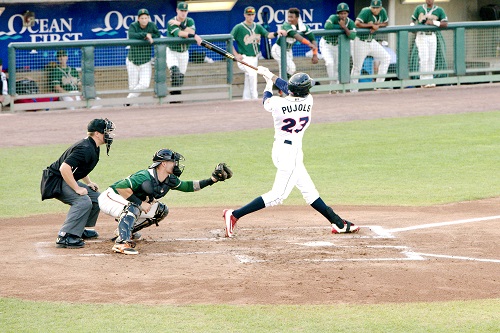

MiLB was off the field in 2020, but ballparks in communities around the country reopened their gates in May and welcomed back the players. The fact that the 2021 season’s first pitch was delayed by a month didn’t seem to dampen the spirits of players or fans.
“Everyone is on the same playing field,” Matt Blood, director of player development for the Baltimore Orioles, told The Washington Post. “It’s not like just our organization has lost the whole year.”
“I’m human again,” Sam Bernabe, a face-masked fan attending the Iowa Cubs’ 2021 season opener at Principal Park in Des Moines, told the Des Moines Register. “It’s just so nice to see smiling faces. Everybody is happy to be back at the park.”
Across the minors, almost 103,500 fans showed up at 47 opening day games, the Associated Pressreported. The largest crowd was at ONEOK Field in Tulsa, Okla., where the Tulsa Drillers lost to the Amarillo (Texas) Sod Poodles in front of 5,004 fans. In 2019, Minor League Baseball’s 176 active teams drew 41,504,077, up 2.6% from 2018, and the ninth-highest total in minor league history.
SI.com put this season’s odd circumstances into perspective, using Minor League Baseball’s most famous stadium as an example: “In the last 607 days, Durham Bulls Athletic Park has alternately served as a place to buy chicken, a place to watch a movie and a place to complete office work. It has sat unsettlingly empty, a mark of an agonizing pandemic year, and it has found new ways to become partially full. It just has not served in the one role for which it was built—a place to watch a ball game.”
Changes and More Changes
Six Minor League teams are playing in new venues this season, according to MLB.com — the most in a single season since 2005.
The Kannapolis (N.C.) Cannon Ballers, Wichita (Kan.) Wind Surge, Fredericksburg (Va.) Nationals and Rocket City Trash Pandas in Madison, Ala., all were supposed to make their new ballpark debuts in 2020. Joining them in 2021 are the Worcester (Mass.) Red Sox and Beloit (Wis.) Snappers. Each of the six teams have marked the occasion with rebrands, MLB.com reports.
That said, the total number of Major League Baseball affiliate teams has shrunk from 160 to 120 after MLB officials announced planslast fall to take over operations of MiLB and oversee them out of MLB’s New York City headquarters.
“That gave MLB latitude to reshape the minors, and it acted fast,” the Associated Press noted. “The short-season leagues were eliminated, as were several full-season affiliates, to take 40 clubs out of the equation.What remains are four levels — Triple-A, Double-A, High-A and Low-A — each with regional names. No more Pacific Coast League, for example — it’s just Triple-A West. Several leagues with over 100 years of history, including the International League (established in 1884), Texas League (1902) and Florida State League (1919), are no more. Three previously independent franchises — the St. Paul Saints, Somerset Patriots and Sugar Land Skeeters — were brought into affiliated ball, meaning 43 clubs lost their connection to the pro ranks. Many of those were folded into new summer leagues for college players, draft hopefuls or independent leagues, keeping baseball in those communities in some form. Some, though, folded entirely.”
Additionally, this season will see many the minors experimenting with rule changes — including larger bases and robot umpires. Yet despite all of the upheaval, nothing compares to the impact COVID-19 had on MiLB organizations, according to BaseballAmerica.com.
“The biggest differences between this year and 2019 … revolve around the effects of the pandemic,” the site explained. “A year with little to no revenue has wrought immense havoc on teams and their front offices, and the continued threat of COVID-19 will mean teams have to shake up the way they do business both in and out of the public view.”
“Despite the struggles we were all having financially and all the staff we had to let go, teams still found ways to make huge impacts on their community to help ease the pandemic,” one Triple-A general manager told the website. “It just shows that the resiliency and creativeness is as strong as ever.”

